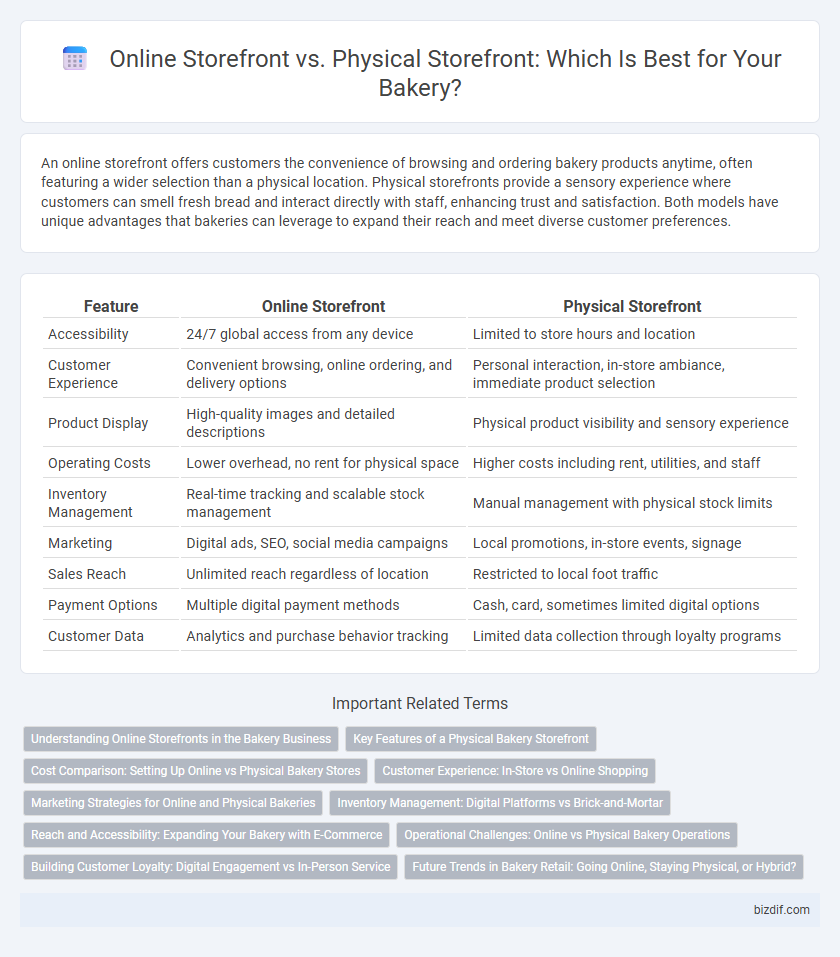An online storefront offers customers the convenience of browsing and ordering bakery products anytime, often featuring a wider selection than a physical location. Physical storefronts provide a sensory experience where customers can smell fresh bread and interact directly with staff, enhancing trust and satisfaction. Both models have unique advantages that bakeries can leverage to expand their reach and meet diverse customer preferences.
Table of Comparison
| Feature | Online Storefront | Physical Storefront |
|---|---|---|
| Accessibility | 24/7 global access from any device | Limited to store hours and location |
| Customer Experience | Convenient browsing, online ordering, and delivery options | Personal interaction, in-store ambiance, immediate product selection |
| Product Display | High-quality images and detailed descriptions | Physical product visibility and sensory experience |
| Operating Costs | Lower overhead, no rent for physical space | Higher costs including rent, utilities, and staff |
| Inventory Management | Real-time tracking and scalable stock management | Manual management with physical stock limits |
| Marketing | Digital ads, SEO, social media campaigns | Local promotions, in-store events, signage |
| Sales Reach | Unlimited reach regardless of location | Restricted to local foot traffic |
| Payment Options | Multiple digital payment methods | Cash, card, sometimes limited digital options |
| Customer Data | Analytics and purchase behavior tracking | Limited data collection through loyalty programs |
Understanding Online Storefronts in the Bakery Business
Online storefronts in the bakery business offer a streamlined platform for customers to browse and purchase fresh baked goods with ease, integrating features like customizable orders and scheduled deliveries. Leveraging e-commerce tools and digital marketing increases reach beyond local foot traffic, enabling bakeries to tap into broader markets and seasonal demand fluctuations. Effective online storefronts also provide valuable customer data analytics, guiding inventory management and personalized marketing strategies.
Key Features of a Physical Bakery Storefront
A physical bakery storefront offers tangible product experience, allowing customers to see, smell, and taste freshly baked goods, which enhances sensory appeal and impulse purchases. Its key features include a welcoming display of baked items, a comfortable seating area for on-site consumption, and personalized customer service that fosters community connection and loyalty. The physical presence also enables direct feedback, immediate product availability, and local brand visibility that is crucial for small business growth.
Cost Comparison: Setting Up Online vs Physical Bakery Stores
Setting up an online bakery storefront typically requires lower initial investment, with costs centered around website development, digital marketing, and packaging materials. Physical bakery stores incur higher expenses including rent, utilities, in-store equipment, and staff wages, making upfront costs significantly greater. Operating online reduces overhead and allows flexible scaling, while physical stores demand steady cash flow for maintenance and location-based expenses.
Customer Experience: In-Store vs Online Shopping
Physical storefronts in bakeries offer sensory-rich experiences where customers can see, smell, and taste fresh products, fostering immediate satisfaction and personal interaction with staff. Online storefronts provide convenience and accessibility, allowing customers to browse diverse baked goods and place orders anytime, supplemented by detailed product descriptions and customer reviews. Both platforms enhance customer experience differently, with physical locations emphasizing sensory engagement and online stores prioritizing ease and informational resources.
Marketing Strategies for Online and Physical Bakeries
Online storefronts leverage social media advertising, SEO, and email marketing to reach a broader audience and drive e-commerce sales for bakeries. Physical storefronts benefit from local SEO, community events, and in-store promotions to attract nearby customers and build brand loyalty. Combining targeted digital campaigns with personalized in-store experiences maximizes customer engagement and revenue growth for bakeries.
Inventory Management: Digital Platforms vs Brick-and-Mortar
Online bakery storefronts utilize integrated inventory management systems that provide real-time tracking of stock levels, automatic updates, and seamless synchronization across multiple sales channels, reducing the risk of overstocking or stockouts. Physical bakery storefronts rely heavily on manual inventory checks, which can lead to discrepancies and slower replenishment cycles due to limited visibility and lack of automation. Digital platforms enable data-driven inventory forecasting based on customer buying patterns, while brick-and-mortar stores depend more on historical sales and in-person assessment, impacting overall efficiency and accuracy in inventory management.
Reach and Accessibility: Expanding Your Bakery with E-Commerce
An online storefront significantly expands a bakery's reach by enabling customers to order from anywhere, breaking geographical limitations inherent to physical stores. E-commerce platforms offer 24/7 accessibility, allowing customers to browse and purchase baked goods at their convenience, driving higher sales potential. Integrating delivery options and digital payment systems further enhances the bakery's accessibility, attracting a broader customer base beyond local foot traffic.
Operational Challenges: Online vs Physical Bakery Operations
Managing inventory poses distinct challenges for online and physical bakery operations, as online storefronts require real-time stock updates and reliable packaging for shipping, while physical stores focus on immediate product availability and minimizing waste. Staffing demands vary, with physical bakeries necessitating customer-facing roles and on-site baking, whereas online bakeries prioritize order fulfillment, digital customer service, and logistics coordination. Delivery logistics add complexity to online bakeries, requiring efficient route planning and temperature control to ensure product freshness, unlike physical storefronts where customers receive freshly baked goods directly on-site.
Building Customer Loyalty: Digital Engagement vs In-Person Service
Building customer loyalty in a bakery benefits from digital engagement through online storefronts by offering personalized promotions and convenient ordering options that enhance repeat purchases. Physical storefronts leverage in-person service to create memorable experiences and foster strong emotional connections through face-to-face interactions and product sampling. Combining digital tools with authentic personal service maximizes customer retention and strengthens brand loyalty.
Future Trends in Bakery Retail: Going Online, Staying Physical, or Hybrid?
Future trends in bakery retail highlight a hybrid model combining online storefronts with physical locations to maximize customer reach and convenience. Increasing demand for contactless purchases drives e-commerce growth, while in-store experiences remain vital for fresh product sampling and community engagement. Integrating seamless online ordering, local delivery, and experiential retail spaces offers bakeries a competitive edge in a shifting market.
Online Storefront vs Physical Storefront Infographic

 bizdif.com
bizdif.com